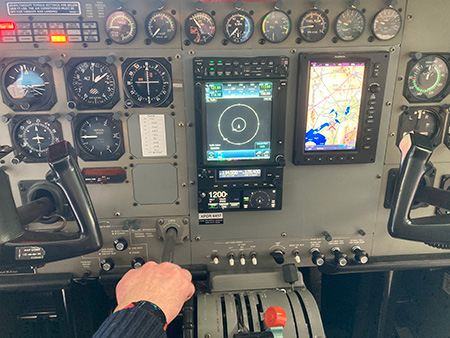Is your ADS-B switched on? How an enjoyable flight on a clear day became a terrifying near miss1.
My wife and I had departed Pauanui aerodrome and were climbing to 2200 feet on a clear sky day, tracking south, just seaward off the coast towards Tauranga.
We were running two radios. One was on Peninsula traffic 124.5 MHz and the other on Harbour CFZ, so we could listen to Waihi Beach traffic if anything in that area transitioned between zones.
The ADS-B was switched on, and no immediate forward traffic was showing on the screen. We were dialled back, cruising at 155 knots indicated, better than 2.5 nautical miles per minute. Our landing lights were on ‘wig-wag’ (visibility-enhancing feature), we heard no immediate radio calls from traffic ahead, and both sets of eyes were ‘viewing outside’.
Looking forward, eyes outside toward Waihi Beach, there was a layer of distant cloud beyond Waihi on the skyline. We made a radio call at Opoutere.
A very close call

In the circuit, you need every advantage you can have. Is your ADS-B switched on? Photo: Carlton Campbell
Two minutes later (~5NM), an aircraft called Whangamatā 1500 feet, tracking north on the coast. We were in the exact same location heading south, separated by 700 feet altitude.
We did not have eyes on a target and there was nothing showing on the ADS-B. I immediately made a same position report, calling 2200 feet. By that time, my wife was scanning forward and I was scanning low left, where the target should be.
In the next instant, an aircraft appeared immediately in front, same altitude, presenting itself in an avoidance turn away.
The total time from his call to avoidance manoeuvre was about 10 seconds, a closing speed of about 275 knots.
Time seemed to stand still. Our reactions were automatic – radio call, wig-wag check, and both of us scanning forward.
The sight of a vertically banked aircraft in front – so close that every detail seems etched in my mind – was downright scary.
The other aircraft continued north. I called them and pointed out they’d said they were somewhere that they weren’t.
I said that was about as close proximity as I ever wanted to come! I asked them if they had ADS-B and, if so, turn it on. They gave an affirmative response.
Another aircraft had departed Pauanui after us, and represented the nearest ADS-B target, some 8NM behind us. I called them and advised them to be vigilant because there was an aircraft coming their way calling where they weren’t.
At that point, the north-bound aircraft suddenly appeared on ADS-B as a signature, having clearly been just turned on.
Within the next 24 hours, I tracked down the aircraft owner and we had a brutally frank chat. They had ADS-B but did not fly with it on unless they really needed to. They had their head down in the cockpit doing something and thought they were still at 1200 feet.
They had seen my wig-wags and said those were amazing, allowing them time to see and avoid me.
What can we learn?
From my perspective, there was little alternative action I could have taken at the time. We were scanning a distant, white-clouded horizon for an aircraft with no wig-wags, and no ADS-B turned on, that was moving directly toward us (appearing as a stationary target rather than moving across our vision line), and the pilot had made no response to my call.
It’s quite possible I could have manoeuvred ‘sight unseen’ into the path of the aircraft while taking precautionary avoidance measures.
I got a fright, no doubt about that, and I was pretty uptight about it at the time, realising things could easily have turned out differently.
I believe the pilot of the other aircraft will turn on their ADS-B in future, pay more attention to their reporting, and keep their head up with eyes outside.
Having been in this situation, I can completely endorse the ‘work together to stay apart’ campaign.
I’m mindful that, in the circuit, you need every advantage you can have when light levels are low or the visual conditions are not helpful (for instance, setting sun, hazy, rain).
This also applies when there are lots of aircraft in the circuit at one time. This occurs at many unattended aerodromes at the weekends – with aerobatics happening over the airfield, low-level circuits by NORDO vintage aircraft, flight school training, private aircraft operations, and helicopters with their own joining procedures.
My three top tips
- When you’re airborne and reporting your position, make sure you know, and say, exactly where you are.
- Keep your eyes outside the aircraft. Don’t become distracted within the cockpit to the point that you lose touch with flying the aircraft.
- If you have ADS-B, turn it on – even if you believe you don’t legally have to.
More information
Find out more about the CAA’s Work Together, Stay Apart safety campaign for unattended aerodromes.
Check out our article about keeping ADS-B enabled: Getting the best from ADS-B.
Footnote
1 This near miss was not near an unattended aerodrome, but many of its elements, including situational awareness and lookout, are regularly present in close calls at such aerodromes.
Main photo: iStock.com/Sandi Smolker
